2017 Peugeot 3008 Hybrid 4 light
[x] Cancel search: lightPage 555 of 578
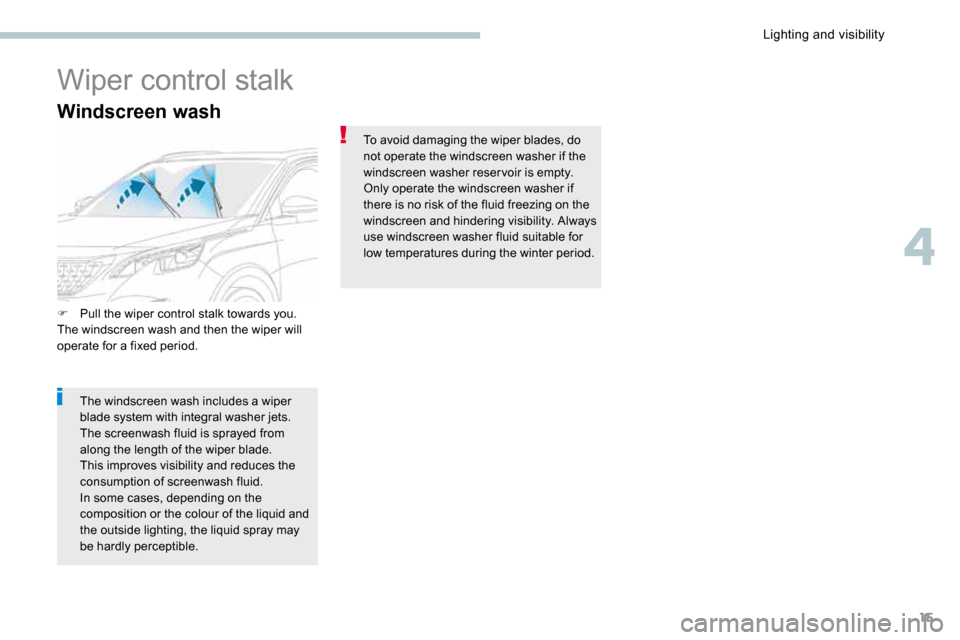
15
Windscreen wash
Wiper control stalk
F Pull the wiper control stalk towards you.
The windscreen wash and then the wiper will
operate for a fixed period.
The windscreen wash includes a wiper
blade system with integral washer jets.
The screenwash fluid is sprayed from
along the length of the wiper blade.
This improves visibility and reduces the
consumption of screenwash fluid.
In some cases, depending on the
composition or the colour of the liquid and
the outside lighting, the liquid spray may
be hardly perceptible. To avoid damaging the wiper blades, do
not operate the windscreen washer if the
windscreen washer reservoir is empty.
Only operate the windscreen washer if
there is no risk of the fluid freezing on the
windscreen and hindering visibility. Always
use windscreen washer fluid suitable for
low temperatures during the winter period.
4
Lighting and visibility
Page 556 of 578
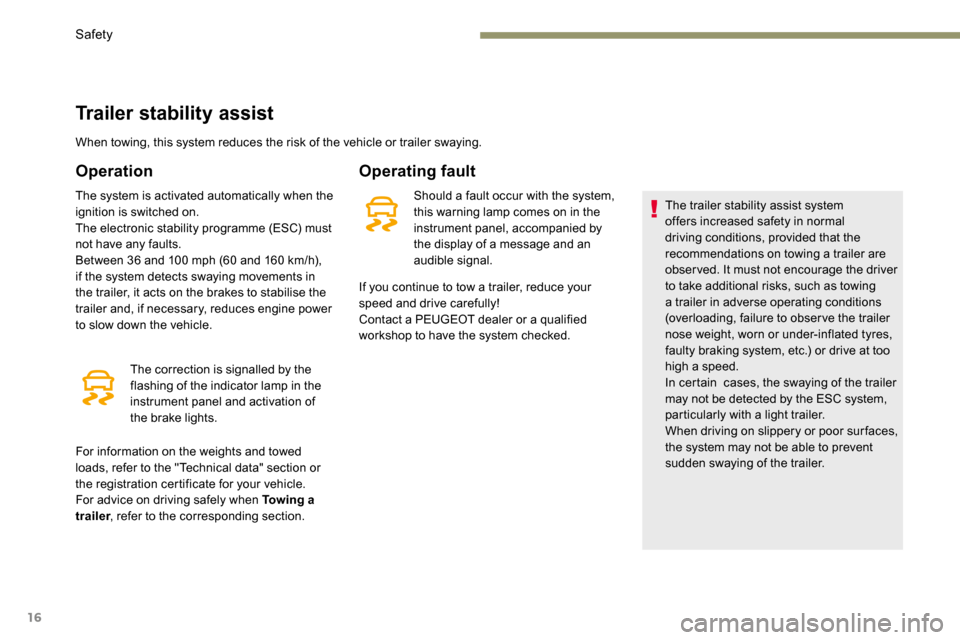
16
Trailer stability assist
When towing, this system reduces the risk of the vehicle or trailer swaying.
Operation
The system is activated automatically when the
ignition is switched on.
The electronic stability programme (ESC) must
not have any faults.
Between 36 and 100 mph (60 and 160 km/h),
if the system detects swaying movements in
the trailer, it acts on the brakes to stabilise the
trailer and, if necessary, reduces engine power
to slow down the vehicle.The correction is signalled by the
flashing of the indicator lamp in the
instrument panel and activation of
the brake lights.
Operating fault
Should a fault occur with the system,
this warning lamp comes on in the
instrument panel, accompanied by
the display of a message and an
audible signal. The trailer stability assist system
offers increased safety in normal
driving conditions, provided that the
recommendations on towing a trailer are
obser ved. It must not encourage the driver
to take additional risks, such as towing
a trailer in adverse operating conditions
(overloading, failure to obser ve the trailer
nose weight, worn or under-inflated tyres,
faulty braking system, etc.) or drive at too
high a speed.
In certain cases, the swaying of the trailer
may not be detected by the ESC system,
particularly with a light trailer.
When driving on slippery or poor sur faces,
the system may not be able to prevent
sudden swaying of the trailer.
If you continue to tow a trailer, reduce your
speed and drive carefully!
Contact a PEUGEOT dealer or a qualified
workshop to have the system checked.
For information on the weights and towed
loads, refer to the "Technical data" section or
the registration certificate for your vehicle.
For advice on driving safely when Towing a
trailer , refer to the corresponding section.
Safety
Page 567 of 578
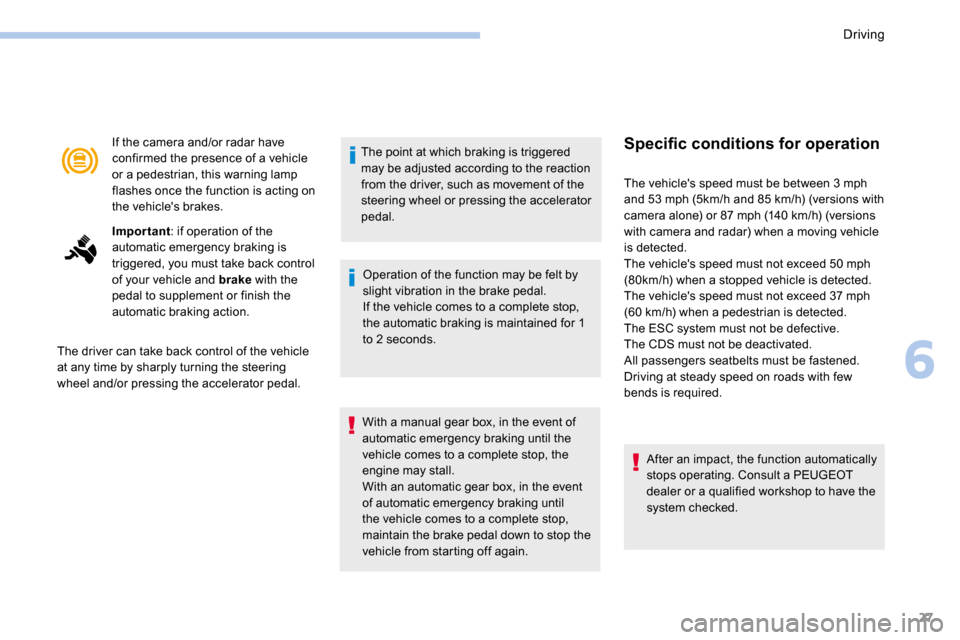
27
If the camera and/or radar have
confirmed the presence of a vehicle
or a pedestrian, this warning lamp
flashes once the function is acting on
the vehicle's brakes.
Important: if operation of the
automatic emergency braking is
triggered, you must take back control
of your vehicle and brake with the
pedal to supplement or finish the
automatic braking action.
The driver can take back control of the vehicle
at any time by sharply turning the steering
wheel and/or pressing the accelerator pedal. The point at which braking is triggered
may be adjusted according to the reaction
from the driver, such as movement of the
steering wheel or pressing the accelerator
pedal.
Operation of the function may be felt by
slight vibration in the brake pedal.
If the vehicle comes to a complete stop,
the automatic braking is maintained for 1
to 2 seconds.
With a manual gear box, in the event of
automatic emergency braking until the
vehicle comes to a complete stop, the
engine may stall.
With an automatic gear box, in the event
of automatic emergency braking until
the vehicle comes to a complete stop,
maintain the brake pedal down to stop the
vehicle from starting off again.Specific conditions for operation
The vehicle's speed must be between 3 mph
and 53 mph (5km/h and 85 km/h) (versions with
camera alone) or 87 mph (140 km/h) (versions
with camera and radar) when a moving vehicle
is detected.
The vehicle's speed must not exceed 50 mph
(80km/h) when a stopped vehicle is detected.
The vehicle's speed must not exceed 37 mph
(60 km/h) when a pedestrian is detected.
The ESC system must not be defective.
The CDS must not be deactivated.
All passengers seatbelts must be fastened.
Driving at steady speed on roads with few
bends is required. After an impact, the function automatically
stops operating. Consult a PEUGEOT
dealer or a qualified workshop to have the
system checked.
6
Driving
Page 568 of 578
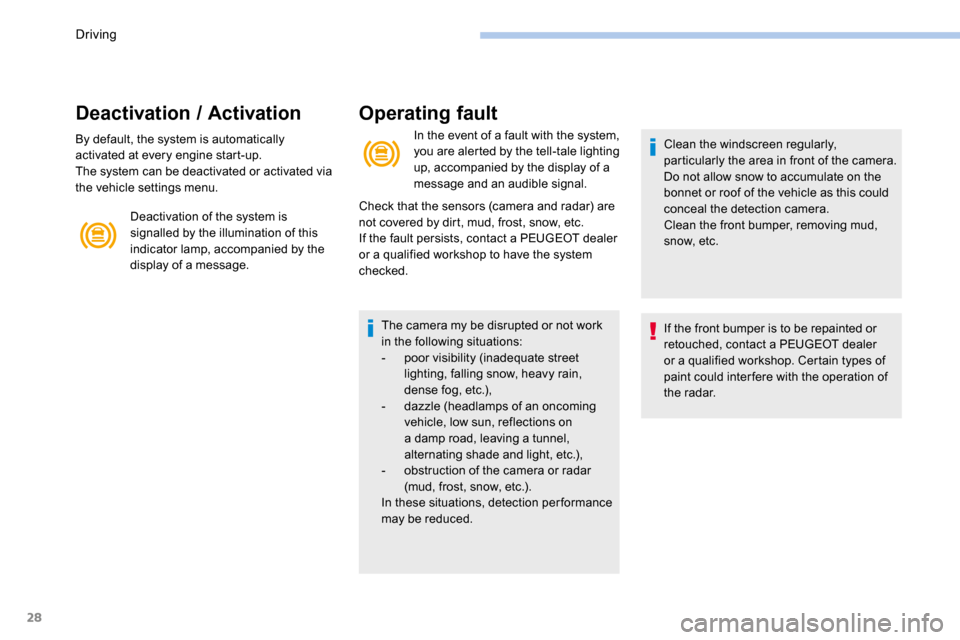
28
Deactivation / Activation
By default, the system is automatically
activated at every engine start-up.
The system can be deactivated or activated via
the vehicle settings menu.Deactivation of the system is
signalled by the illumination of this
indicator lamp, accompanied by the
display of a message. Clean the windscreen regularly,
particularly the area in front of the camera.
Do not allow snow to accumulate on the
bonnet or roof of the vehicle as this could
conceal the detection camera.
Clean the front bumper, removing mud,
snow, etc.
If the front bumper is to be repainted or
retouched, contact a PEUGEOT dealer
or a qualified workshop. Certain types of
paint could inter fere with the operation of
the radar.
Operating fault
Check that the sensors (camera and radar) are
not covered by dirt, mud, frost, snow, etc.
If the fault persists, contact a PEUGEOT dealer
or a qualified workshop to have the system
checked.In the event of a fault with the system,
you are alerted by the tell-tale lighting
up, accompanied by the display of a
message and an audible signal.
The camera my be disrupted or not work
in the following situations:
- poor visibility (inadequate street
lighting, falling snow, heavy rain,
dense fog, etc.),
- dazzle (headlamps of an oncoming
vehicle, low sun, reflections on
a damp road, leaving a tunnel,
alternating shade and light, etc.),
- obstruction of the camera or radar
(mud, frost, snow, etc.).
In these situations, detection performance
may be reduced.
Driving
Page 569 of 578
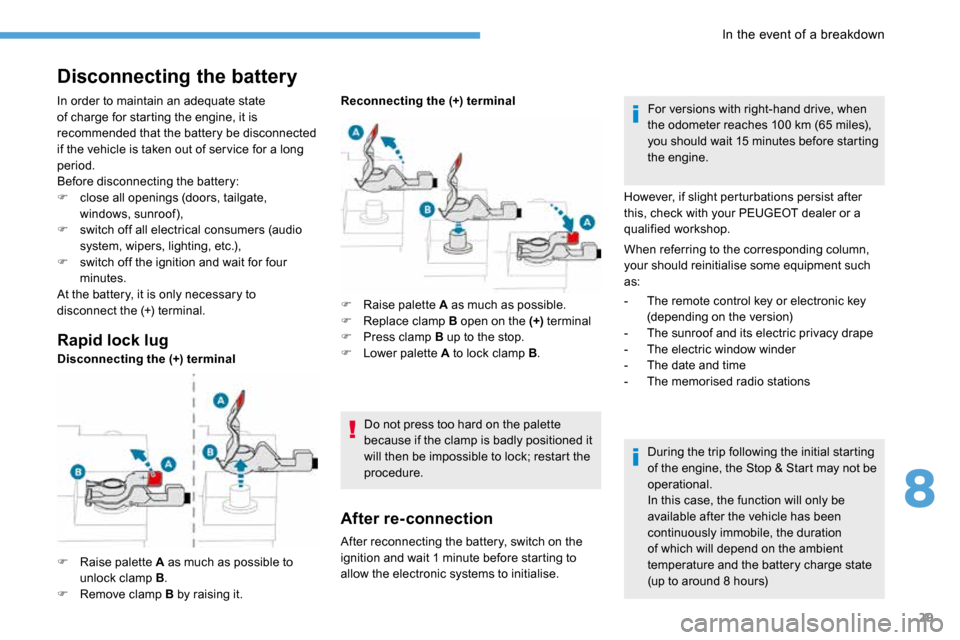
29
Disconnecting the battery
Rapid lock lug
F Raise palette A as much as possible to
unlock clamp B .
F Remove clamp B by raising it. F
Raise palette A as much as possible.
F Replace clamp B open on the (+) terminal
F Press clamp B up to the stop.
F Lower palette A to lock clamp B .
Do not press too hard on the palette
because if the clamp is badly positioned it
will then be impossible to lock; restart the
procedure.
After re-connection
During the trip following the initial starting
of the engine, the Stop & Start may not be
operational.
In this case, the function will only be
available after the vehicle has been
continuously immobile, the duration
of which will depend on the ambient
temperature and the battery charge state
(up to around 8 hours)
After reconnecting the battery, switch on the
ignition and wait 1 minute before starting to
allow the electronic systems to initialise. For versions with right-hand drive, when
the odometer reaches 100 km (65 miles),
you should wait 15 minutes before starting
the engine.
However, if slight perturbations persist after
this, check with your PEUGEOT dealer or a
qualified workshop.
When referring to the corresponding column,
your should reinitialise some equipment such
as:
- The remote control key or electronic key
(depending on the version)
- The sunroof and its electric privacy drape
- The electric window winder
- The date and time
- The memorised radio stations
Disconnecting the (+) terminal Reconnecting the (+) terminal
In order to maintain an adequate state
of charge for starting the engine, it is
recommended that the battery be disconnected
if the vehicle is taken out of ser vice for a long
period.
Before disconnecting the battery:
F close all openings (doors, tailgate,
windows, sunroof),
F switch off all electrical consumers (audio
system, wipers, lighting, etc.),
F switch off the ignition and wait for four
minutes.
At the battery, it is only necessary to
disconnect the (+) terminal.
8
In the event of a breakdown
Page 570 of 578
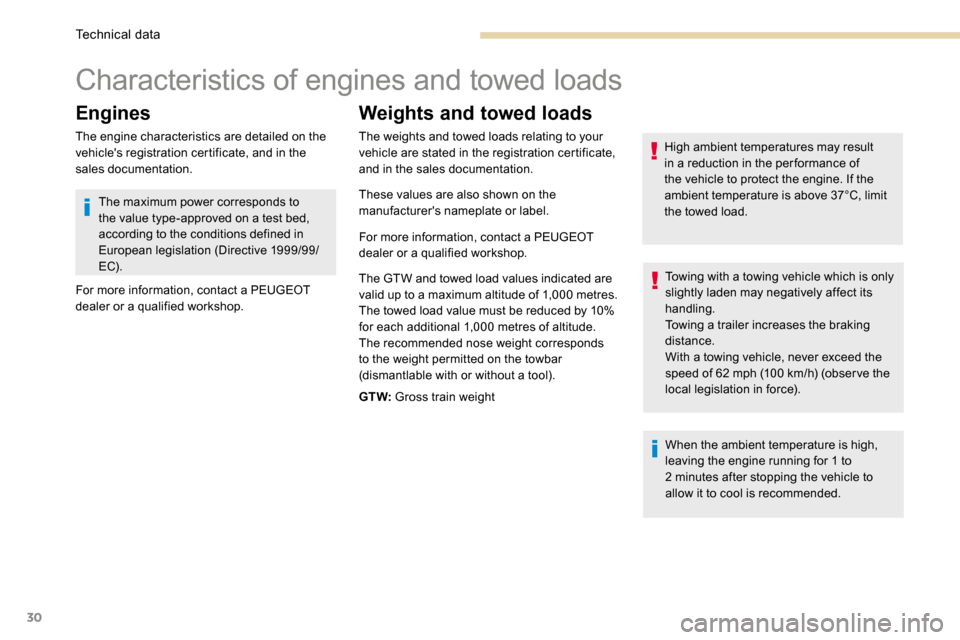
30
Characteristics of engines and towed loads
Engines
The engine characteristics are detailed on the
vehicle's registration certificate, and in the
sales documentation.
Weights and towed loads
When the ambient temperature is high,
leaving the engine running for 1 to
2 minutes after stopping the vehicle to
allow it to cool is recommended.
The weights and towed loads relating to your
vehicle are stated in the registration certificate,
and in the sales documentation.
These values are also shown on the
manufacturer's nameplate or label.
For more information, contact a PEUGEOT
dealer or a qualified workshop.
The GTW and towed load values indicated are
valid up to a maximum altitude of 1,000 metres.
The towed load value must be reduced by 10%
for each additional 1,000 metres of altitude.
The recommended nose weight corresponds
to the weight permitted on the towbar
(dismantlable with or without a tool).
GT W:
Gross train weight High ambient temperatures may result
in a reduction in the per formance of
the vehicle to protect the engine. If the
ambient temperature is above 37°C, limit
the towed load.
Towing with a towing vehicle which is only
slightly laden may negatively affect its
handling.
Towing a trailer increases the braking
distance.
With a towing vehicle, never exceed the
speed of 62 mph (100 km/h) (obser ve the
local legislation in force).
The maximum power corresponds to
the value type-approved on a test bed,
according to the conditions defined in
European legislation (Directive 1999/99/
EC).
For more information, contact a PEUGEOT
dealer or a qualified workshop.
Technical data